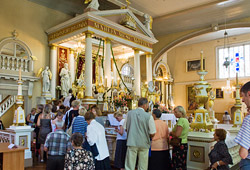Piety
Very old traditions of popular Marian piety are still very much alive at Pivašiūnai. On Sundays, the Little Office of the Blessed Virgin Mary is chanted and the Holy Rosary is prayed or sung. For important feast days, flower wreaths are woven to decorate the painting of the Mother of God. Indeed, prayer to Mary is constant in this church, as requested in the last will and testament of its founder Jonas Klockis.
Prior to World War I, pilgrims mostly came from the regions of Dzūkija, Vilnius and Lyda. They would travel in immense processions that lasted several days, carrying church banners and religious images, and seeking refuge at night at farms along the way. Among the pilgrims there were always sick and lame people as well as beggars, whom people would generously help.
The tradition of such organized trips to indulgenced feasts revived again when the Soviet occupation ended and independence was regained. In fact, Pivašiūnai has become one of Lithuania’s main pilgrimage hubs. Many pilgrims, especially young people, travel at least part of the way on foot. Walking pilgrimages from parishes in the nearby towns of Jieznas, Alytus, and Užuguostis have long been common. During independence in the first half of the 20th century, groups of young people would journey by foot to Pivašiūnai from the Kaišiadorys Cathedral – a distance of 78 km. Indeed, pilgrims have come walking from as far as Druskininkai, Vilnius, Kazlų Rūda and Kalvarija.
The eight days of the indulgenced feast of the Assumption, or “Žolinė”, is when the largest groups of pilgrims gather at Pivašiūnai. The Assumption has been the main indulgenced feast at the shrine since 1988, when its famous painting of the Mother of God was crowned on the eve of that feast. Since 1988, it has become customary to honour Our Lady of Pivašiūnai in a special way on the 15th day of every month. Before Soviet times, Pivašiūnai was also known for an annual indulgenced feast to celebrate the Nativity of Mary, which lasted 3 days and included the 40 Hours Devotion.
At the end of the 18th century, indulgenced feasts here included those of St John the Baptist, of Sts Benedict, Maurus and Scholastica, and of the Tertiary Fraternity of the Scapular of the Blessed Virgin Mary. After all, the church of Pivašiūnai was named after not only Mary’s Assumption, but also St John the Baptist, patron saint of founder Jonas Klockis, and St Benedict, whose spiritual children laboured here. From the 18th century, pilgrims could buy food and religious items at fairs that were held during the indulgenced feasts. In the churchyard, those who were thirsty could drink water from the springs of Pivašiūnai.
In recent decades, it has become customary to dedicate each of the eight days in the annual feast of the Assumption to a specific important intention. Prayer is thus offered for families, young people, the sick and the abandoned, for missionaries, farmers, teachers and pupils, for the defence of life and for peace. Catechesis sessions and special events for youth are also held.








